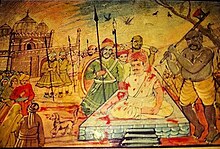Gokula
Veer Gokula Dev | |
|---|---|
 Painting of the execution of Jat rebel leader Gokula by dismemberment | |
| Native name | गोकुल देव |
| Birth name | Gokul Dev |
| Born | Tilpat,Delhi Subah,Mughal Empire(Present-dayFaridabad district,Haryana) |
| Died | 1 January 1670 Agra,Agra Subah,Mughal Empire(Present-dayUttar Pradesh) |
| Known for |
|
| Relations | Madu Haga (father) Sindhuraj Haga (brother) Jhaman Haga (brother) Saman Haga (brother) |
Gokula(also known asVeer GokulaorGokul Dev;died on 1 January 1670) was aZamindarofTilpatregion (of present-dayHaryana) who led the Hindu Zamindars (specificallyJats) to a revolt against Mughal rule, during the reign of the Mughal EmperorAurangzeb.[1][2]
Early life
[edit]Gokula (originallyOlaorGokul Dev) was born in aHindu Jatfamily ofTilpatregion (of Haga/Agre/Agha gotra) to Madu Haga and was the second son of the family in four brothers.[3]
Battle of Tilpat
[edit]The Battle of Tilpat was fought betweenJatsand theMughal Empirein 1669.[4]MughalSubahdars(governors) imposed heavy taxes on the farmers of this region due to bad financial conditions of the empire resulting from the continuous military expansion in the southern regions of thesubcontinent.Due to this, dissatisfaction and anger among the localZamindarsarose and took the form of rebellion against Mughals. To suppress the rebellion Aurangzeb sent his commanders Hasan Ali Khan and Brahmdev Sisodia with a big army contingent of rajput and mughal soldiers as a reinforcement toSadabadcantonment commanded by Abdul Nabi. The Jat chief Gokula, son ofTilpatZamindar Madu Singh Jat led the rebellion of farmers.[5]First confrontations of the rebellion continued for 4 days with the seizing ofTilpatand the farmers' counterattacks.
Rebellion
[edit]Abdul Nabi had also committed some excesses on the Jat Hindus, which incited the rebellion.[6]Abdul Nabi established a cantonment near Gokul Singh and conducted all his operations from there. A battle was fought at the village of Sahora where in May 1669 Abdul Nabi was killed while attempting to seize it. Gokula and his fellow farmers moved further, attacking and destroying theSadabadcantonment. This inspired theHindusto fight against the Mughal rulers, who were there to destroy all Hindu rebels in exchange of Gokula's land and territories.[7]The fighting continued for five months.[8][9]In the meantime, after Gokula's death,Churamanhad strengthened the Jat fort ofSinsininearBharatpur,and they sacked regions aroundAgraand Delhi.Akbar'stombwaslootedand according to legends the grave of Akbar was dug up.[10]
Second Battle of Tilpat
[edit]| Second Battle of Tilpat | |||||||||
|---|---|---|---|---|---|---|---|---|---|
| Part ofMughal-Jat conflict | |||||||||
| |||||||||
| Belligerents | |||||||||
| Gokula's army | Mughal Empire | ||||||||
| Commanders and leaders | |||||||||
| Gokula | Abdul Nabi (KIA), Hasan Ali, Amanulla | ||||||||
| Strength | |||||||||
| 15,450 Jats | Reinforcements of 20,000 Mughal soldiers, 10,000 musketeers, 5,000 rocketmen and 250 artillery pieces | ||||||||
| Casualties and losses | |||||||||
| 13,500 to 13,905Jats | total (16,000 to 17,000) | ||||||||
In 1669, Gokula Singh with 20,000 followers faced the Mughals 20 miles fromTilpat.Abdul Nabi attacked them. At first he appeared to be gaining ground, but in the middle of the fighting he was killed on 12 May 1669 (21stDhu al Hijja,1079 A.H.).[11][12]They retreated to Tilpat, where Hasan Ali followed and besieged them aided by reinforcements of 10,000 musketeers, 5,000rocketmen,and 250 artillery pieces. Amanulla, theFaujdarof the environs ofAgrawas also sent to reinforce Hasan Ali.[13]
Aftermath
[edit]Gokula and his uncle Uday Singh Jat won the battle. But after that Aurangzeb sent a big army to catch them. The Mughals caught them and then killed them on 1 January 1670 near Agra Fort. Gokula Jat and supporters became martyrs.
Gokula'sson & daughterwas made to convert to Islam byAurangzeb.
Death
[edit]After his capture, Jat leader Gokula had hislimbs cut offon orders of Mughal emperorAurangzeb,near Agra kotwali in January 1670.
See also
[edit]References
[edit]- ^Singh, K Natwar."Maharaja Suraj Mal -1707-1763".Maharaja Suraj Mal -1707-1763 by K Natwar Singh[महाराजा सूरजमल -1707-1763 लेखक: के नटवर सिंह]. p. Pags - 7.
- ^R. C. Majumdar,H.C. Raychaudhari, Kalikinkar Datta:An Advanced History of India,2006, p.490
- ^Narendra Singh Verma: Virvar Amar Jyoti Gokul Singh (Hindi), Sankalp Prakashan, Agra, 1986, p. 5
- ^Jahan, Dr.Ishrat (29 December 2018).Socio-Cultural life in Medieval History.Lulu.com. p. 52.ISBN9780359222803.
- ^Nagar, Ishwardas (1978). Tasneem Ahmad (ed.).Ishwardas Nagar's Futuhat-i-Alamgiri.Idarah-i Adabiyat-i Delli. p. 83.
- ^Chandra, Satish.History of medieval India.Orient Blackswan.
- ^Narendra Singh Verma: Virvar Amar Jyoti Gokul Singh (Hindi), Sankalp Prakashan, Agra, 1986, p. 34
- ^Narendra Singh Verma: Virvar Amar Jyoti Gokul Singh (Hindi), Sankalp Prakashan, Agra, 1986, p. 35
- ^Sen, Sailendra (2013).A Textbook of Medieval Indian History.Primus Books. p. 188.ISBN978-9-38060-734-4.
- ^Reddy, Krishna (1960).Indian History.McGraw Hill.ISBN978-0-07-132923-1.
- ^Sarkar, Jadunath."Maasir-i-Alamgiri A history of emperor Aurangzeb Alamgir".AhleSunnah Library.Archived fromthe originalon 11 November 2014.Retrieved19 November2015.
- ^जाट महिलाओं ने जौहर किया। गोकुला ने इस्लाम स्वीकारने से मना कर दिया[Jat women committed Jauhar. Gokula refused to accept Islam] (in Hindi). Anmol. 1996. p. 121.ISBN978-81-7041-859-7.
- ^Sharmaji, Gautama (1990).Valour and Sacrifice: Famous Regiments of the Indian Army.Allied Publishers. pp. 152–153.ISBN9788170231400.Retrieved19 November2015.
- ^Encyclopaedia Indica: Princely states in colonial India-I.Anmol Publications. 1996.ISBN978-81-7041-859-7.
